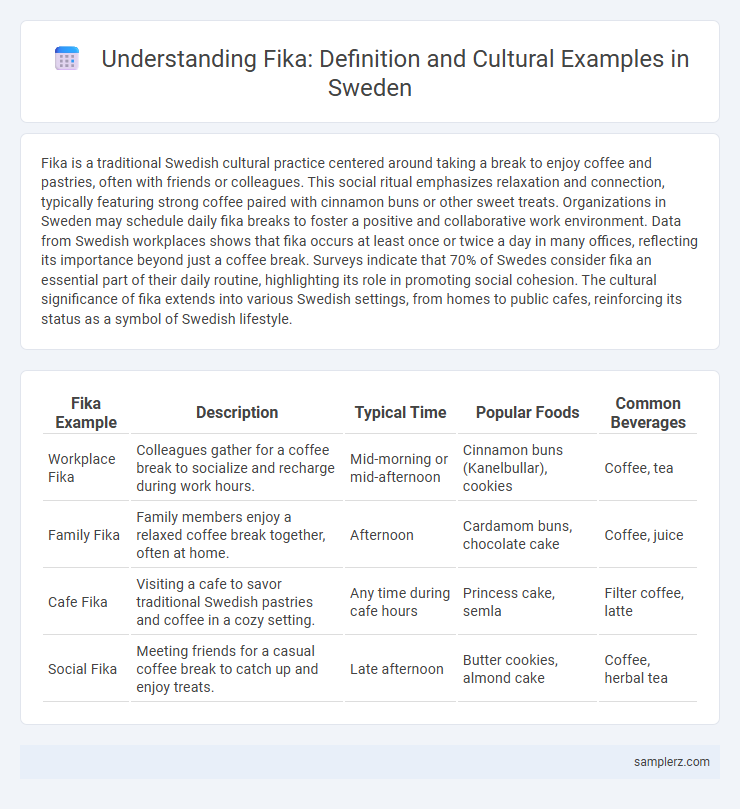Fika is a traditional Swedish cultural practice centered around taking a break to enjoy coffee and pastries, often with friends or colleagues. This social ritual emphasizes relaxation and connection, typically featuring strong coffee paired with cinnamon buns or other sweet treats. Organizations in Sweden may schedule daily fika breaks to foster a positive and collaborative work environment. Data from Swedish workplaces shows that fika occurs at least once or twice a day in many offices, reflecting its importance beyond just a coffee break. Surveys indicate that 70% of Swedes consider fika an essential part of their daily routine, highlighting its role in promoting social cohesion. The cultural significance of fika extends into various Swedish settings, from homes to public cafes, reinforcing its status as a symbol of Swedish lifestyle.
Table of Comparison
| Fika Example | Description | Typical Time | Popular Foods | Common Beverages |
|---|---|---|---|---|
| Workplace Fika | Colleagues gather for a coffee break to socialize and recharge during work hours. | Mid-morning or mid-afternoon | Cinnamon buns (Kanelbullar), cookies | Coffee, tea |
| Family Fika | Family members enjoy a relaxed coffee break together, often at home. | Afternoon | Cardamom buns, chocolate cake | Coffee, juice |
| Cafe Fika | Visiting a cafe to savor traditional Swedish pastries and coffee in a cozy setting. | Any time during cafe hours | Princess cake, semla | Filter coffee, latte |
| Social Fika | Meeting friends for a casual coffee break to catch up and enjoy treats. | Late afternoon | Butter cookies, almond cake | Coffee, herbal tea |
Understanding Fika: A Swedish Cultural Tradition
Fika in Sweden represents more than just a coffee break; it is a cherished cultural tradition emphasizing social connection and relaxation. Typically involving coffee paired with pastries like cinnamon buns, fika fosters community bonding and workplace camaraderie. This ritual occurs multiple times daily, reflecting Sweden's prioritization of work-life balance and mindfulness.
The Origins and History of Fika
Fika, a cherished Swedish tradition, originated in the early 18th century as a social coffee break emphasizing community and relaxation. The term itself is believed to be a reversed syllable form of the word "kaffi," an old Swedish word for coffee, highlighting the cultural importance of coffee in Swedish daily life. Over time, fika evolved from a simple coffee pause into a fundamental cultural ritual symbolizing togetherness, work-life balance, and mindful social interaction in Sweden.
Typical Foods and Drinks Served During Fika
Fika in Sweden typically includes a variety of sweet pastries such as cinnamon buns (kanelbullar) and cardamom buns, often accompanied by crisp biscuits or almond cake. Coffee is the essential beverage served, brewed strong and enjoyed black or with milk, reflecting the Swedish preference for rich flavors. Various jams, butter, and sometimes cheese complement the treats, creating a balanced and traditional fika experience.
The Social Role of Fika in Sweden
Fika in Sweden functions as more than just a coffee break; it serves as a vital social ritual that strengthens community bonds and fosters workplace camaraderie. This cultural practice encourages people to pause their daily routines, engage in meaningful conversations, and build trust through shared moments over coffee and pastries. Regular fika sessions contribute significantly to Sweden's emphasis on work-life balance and social cohesion.
Fika Etiquette: Do’s and Don’ts
Fika etiquette in Sweden emphasizes taking a mindful break to enjoy coffee and pastries, fostering social connection and relaxation. It is customary to wait for everyone to be served before starting, avoid using phones, and engage in light, positive conversation. Offering to pay or at least taking turns sponsoring the fika is appreciated, while rushing or skipping the fika altogether is considered impolite.
Fika in Swedish Workplaces
Fika in Swedish workplaces fosters social bonding and enhances productivity by encouraging employees to take regular coffee breaks together. This cultural practice involves sharing coffee, pastries, and light conversation, promoting a relaxed yet collaborative atmosphere. Companies that embrace fika report improved team cohesion and employee well-being.
Seasonal Variations of Fika Treats
Seasonal variations of fika treats in Sweden reflect the country's rich culinary traditions and changing harvests, with cinnamon buns (kanelbullar) popular year-round and saffron buns (lussekatter) specifically enjoyed during Advent and Christmas. In spring, lighter pastries with berries and rhubarb become common, while autumn features apple and cinnamon flavors in cakes and pies, highlighting local fruit harvests. These shifting fika offerings capture the essence of Swedish culture by celebrating seasonal ingredients and festive occasions.
How Fika Strengthens Community Bonds
Fika in Sweden fosters community bonds by encouraging social interaction over coffee and pastries, creating a relaxed environment for sharing stories and building trust. This tradition promotes inclusivity and equal status among participants, enhancing a sense of belonging and collective identity. Regular fika breaks contribute to stronger workplace collaboration and community cohesion by reinforcing interpersonal relationships.
Fika in Modern Swedish Cafés
Modern Swedish cafes incorporate fika as a cherished social ritual emphasizing coffee, pastries, and conversation. This tradition fosters community bonding and relaxation, with popular items like cinnamon buns (kanelbullar) and strong brewed coffee enhancing the experience. Contemporary cafes often blend minimalistic Scandinavian design with cozy atmospheres to create inviting spaces for fika gatherings.
Incorporating Fika Into Everyday Life
Fika, a cherished Swedish tradition, involves taking intentional breaks to enjoy coffee and pastries while socializing, fostering relaxation and connection. Incorporating fika into everyday life promotes work-life balance and enhances productivity by encouraging regular pauses in daily routines. This cultural practice is integral to Swedish identity, emphasizing mindfulness and community in both personal and professional settings.

example of fika in Sweden Infographic
 samplerz.com
samplerz.com